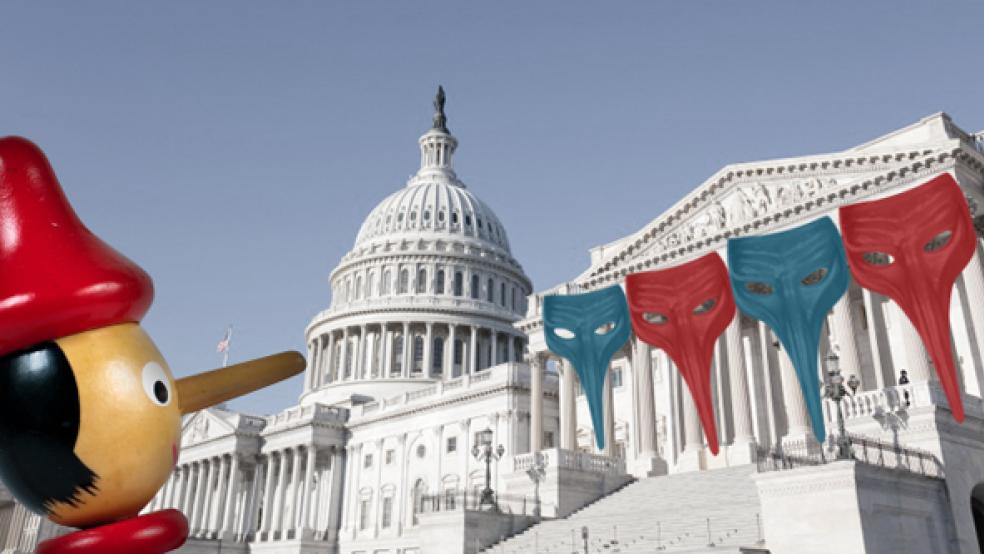It’s hard enough wading through the tax code to prepare your personal tax returns. But parsing the blizzard of proposals for tax hikes, tax cuts and tax reform offered by President Obama, lawmakers and GOP presidential candidates can be overwhelming.
It’s not just that taxes and their implications for the economy are complicated. It’s that politicians often shade facts about the U.S. tax system to their advantage, using contradictions, half-truths or downright distortions to make their case. We hear constantly that individuals and businesses are saddled with excessive tax rates, that the wealthy are paying their fair share, that corporate tax rates are oppressive and discourage economic growth, and that many low-come Americans pay no taxes at all.
Tax reform is a dominant theme along the presidential campaign trail, and Mitt Romney, Herman Cain, Newt Gingrich and others are wielding major tax schemes to try to set themselves apart from the others. Yet it's impossible for the average voter to come to sound conclusions about candidates' ideas when they’re getting fragmentary or distorted explanations about the realities of the tax system.
The failure of the congressional “Super Committee” to agree to a plan to reduce the deficit by at least $1.2 trillion underscores the vast divergence of political and ideological views over how Americans should be taxed. As you follow along, consider these common falsehoods or shades of truth often bandied about:
Americans’ tax rates are high
By historical standards, current federal tax rates are around their lowest levels ever. Even if the Bush tax cuts expire at the end of next year, and the top marginal income tax rate rises to 39.6 percent, that’s still low by historical standards.
Since the income tax became permanent in 1913, the top rate has only been lower than today’s rate in 16 years – most recently between 1988 and 1992, when the top rate was 28 percent and then was bumped to 31 percent as a deficit-cutting measure under President George H. W. Bush.
So for 74 years, the top tax rate has been higher than it is today, and for 63 years it was higher than 39.6 percent-- usually significantly higher: For 54 years, the top rate was at least 50 percent. Through the 1950s and early 1960s, it was over 90 percent.
Of course, income taxes are just one category of taxes. Americans are being taxed from every angle: There are payroll taxes, the alternative minimum tax, taxes on sales, investment income and gasoline, for example. And don’t forget state and local taxes.
But the Bureau of Economic Analysis concluded that the overall tax burden has been shrinking. The share of Americans’ income that went to federal, state and local taxes shrank from 14.4 percent ten years ago, to 12.4 percent in 2008, to 9.4 percent in 2010.
Tax breaks passed by President Obama -- including the Making Work Pay credit, increased tax credits in education, and earned income tax credits -- contribute to the reduced burden.
America’s poorest pay no taxes
A recent study by the Joint Committee on Taxation found that 51 percent of American households – those at the lower end of the income scale -- pay no income tax. The finding has been repeatedly cited by lawmakers such as Sen. Orrin Hatch, R-Utah, as reason to create a system in which these folks have to ante up like the rest of us.
The current system may well need an overhaul, but let’s be clear: The 51 percent reflects just income taxes. It doesn’t account for other taxes paid by this group – particularly the payroll tax, which is automatically deducted from paychecks to fund Medicare and Social Security.
Factor in payroll taxes, and that proportion shrinks to 14 percent -- a group made up primarily of elderly, disabled or unemployed taxpayers, according to the non-partisan Tax Policy Center.
Also, note that the 51 percent figure was for a year of high unemployment. In more typical, higher employment years, 35 percent to 40 percent of households owe no federal income tax, according to the Center on Budget and Policy Priorities.
The wealthy are paying their fair share in taxes
Obama wants to raise taxes on the wealthy, but critics say the wealthy are already paying more than their fair share, citing this fact: The top 1 percent of earners (those with adjusted gross income of $410,095 or more) receives 23 percent of all wages, but they paid 40 percent of income taxes, according to IRS data.
But contrary to what that data implies, the overall tax burden on the wealthy has been shrinking much faster than on middle-class taxpayers. That’s because the share of total income in the U.S. earned by wealthy folks has been rising for decades. The top 1 percent of earners now earns 25 percent of all income, up from 10 percent in the 1970s. Meanwhile, tax rates have been declining.
The corporate tax rate is too high
The U.S. corporate tax rate, at 35 percent, is the second highest in the world next to Japan. Many corporate CEOs and lawmakers favor lowering the rate, saying the 35 percent puts U.S. businesses at a competitive disadvantage in the world market.
But few, if any, corporations actually pay the 35 percent rate thanks to numerous subsidies and tax breaks. Some corporations have years in which they owe zero tax, despite having earned profits. According to Citizens for Tax Justice, 30 companies, including General Electric, Verizon Communications and Wells Fargo, paid no income tax in 2008, 2009 and 2010 despite logging substantial profits.
Among corporations that do pay, rates vary dramatically by industry. For example, companies specializing in information, such as Internet companies, pay an average 19 percent rate, while retailers pay 31 percent and manufacturers 30 percent, according to a study by Kevin S. Markle of Dartmouth College and Douglas A. Shackelford of University of North Carolina.
The tax competitiveness of U.S. companies compared to foreign companies, based on effective corporate rates, varies by industry. For example, U.S. financial companies pay an average of 20 percent, which is lower than the averages for nations in Europe, Latin America, Asia, Australia, among others, according to the Markle and Shackelford study. But the average rate paid by U.S. manufacturing companies (26 percent) is only topped in France and Japan.
The corporate income tax may need reform, but not because corporations are paying a 35 percent rate. It’s because of the numerous tax breaks and loopholes embedded in corporate tax law, and how unevenly they are applied across the corporate landscape.



